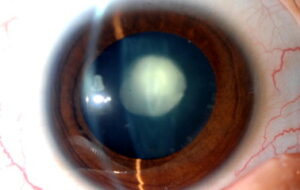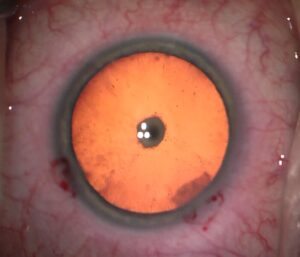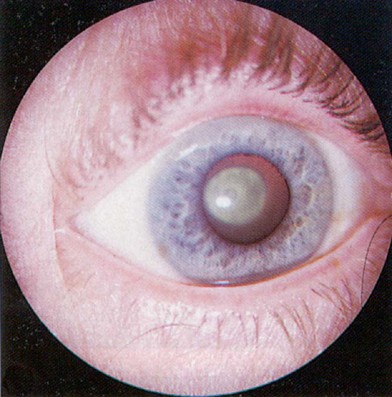A posterior polar cataract is a type of cataract that affects the back of the lens in your eye. This condition can cause blurry vision and problems with glare. In some cases, it may even lead to blindness. If you are experiencing any symptoms of a posterior polar cataract, it is important to see a doctor right away for treatment. In this blog post, we will discuss what causes posterior polar cataracts and how they can be treated.
Contents
What Is A Posterior Polar Cataract?
 A posterior polar cataract is a type of cataract that affects the back of the lens. It is a type of subcapsular cataract and is caused by changes in the lens proteins that accumulate in one area of the lens, creating a cloudy spot. This can affect both eyes but is more common in people over 60 years old.
A posterior polar cataract is a type of cataract that affects the back of the lens. It is a type of subcapsular cataract and is caused by changes in the lens proteins that accumulate in one area of the lens, creating a cloudy spot. This can affect both eyes but is more common in people over 60 years old.
It is estimated that posterior polar cataracts make up around 5-10% of all cataracts. Many people might not see it because it is located in the back of the lens and can be hard to spot. But with the right information and awareness, you can be sure to manage it accordingly.
What Are Some Common Symptoms?
There are a few common symptoms associated with posterior polar cataracts, these include:
- Blurred vision: It is common to experience blurry vision when the cataract starts to form, this can be quite gradual.
- Glare: As the lens of your eye becomes foggy due to the cataract, light is scattered more easily and this can cause a strong glare that often makes it difficult to drive at night.
- Changes in color perception: The cataract can cause colors to appear faded or washed out.
- Double vision: As the cataract progresses, it can cause images to appear doubled or blurry.
- Decreased night vision: Many people with posterior polar cataracts find that their night vision is significantly decreased and they may experience difficulty adjusting to low-light environments.
These are generally the most common signs of a posterior polar cataract, however, there are other possible symptoms that may be experienced as the condition progresses. If you are experiencing any of these symptoms, you must speak with your doctor or a qualified optometrist as soon as possible.
What Causes Posterior Polar Cataracts?
This might be the most common form of cataract due to aging. It is directly related to a hardened or degenerated lens that affects how light passes through it, resulting in cloudy vision and a decrease in visual acuity.
Other causes may include:
- Diabetes: It is also known that people with diabetes are at a higher risk of developing posterior polar cataracts.
- Ultraviolet Rays: Long-term exposure to ultraviolet rays can cause the lens of your eye to become hardened and cloudy.
- Congenital Cataract: In some cases, congenital cataracts may lead to posterior polar cataracts due to an abnormality of the lens.
- Drug use (such as steroids): If a person is taking large doses of steroids for a prolonged period of time, it can cause an increase in posterior polar cataracts.
- Genetic abnormalities: This can lead to the formation of a posterior polar cataract due to the malfunctioning of certain genes.
- Eye trauma: Finally, if someone has experienced a major trauma to their eye, it can lead to posterior polar cataracts.
All in all, these causes can lead to the development of posterior polar cataracts. Be sure to discuss with a professional to get the best diagnosis and advice for your individual needs.
How Is It Diagnosed?
The diagnosis of posterior polar cataracts is made through a comprehensive eye exam. Your doctor will use a slit lamp to examine your lens and check for signs of a posterior polar cataract.
Other tests that may be used to diagnose a posterior polar cataract include:
- An ultrasound: It is used to measure the size and shape of your lens.
- A dilated fundus exam: This is a non-invasive test that uses an ophthalmoscope to check for signs of a posterior polar cataract.
- CT scan: It is required in cases where the posterior polar cataract is not visible during a slit lamp exam.
Overall, it is important to understand the symptoms and diagnosis of posterior polar cataracts. So that you can get the correct treatment.
How Can You Treat Posterior Polar Cataracts?
 When it comes to treating posterior polar cataracts, the primary approach is surgery. This type of cataract requires a more specialized kind of procedure and thus should only be done by experienced eye surgeons. The typical steps involved in this procedure include:
When it comes to treating posterior polar cataracts, the primary approach is surgery. This type of cataract requires a more specialized kind of procedure and thus should only be done by experienced eye surgeons. The typical steps involved in this procedure include:
- Preoperative evaluation – This involves assessing your overall health, checking your eyesight, and discussing the risks and benefits of different surgical techniques with your doctor.
- Anesthesia – Depending on the complexity of the case, either local or general anesthesia may be used to ensure a comfortable procedure.
- Phacoemulsification – This is an advanced surgical technique that uses sound waves to break up and remove the cataract. The sound waves are generated by a device called the phacoemulsifier, which is inserted into your eye during the procedure.
- Intraocular lens implantation – Once the cataract has been removed, an intraocular lens (IOL) may be implanted in order to replace your natural lens and help restore your vision.
Recovery from a posterior polar cataract surgery can take several weeks, and there are certain precautions that must be taken to help ensure success. These include:
- Wearing protective eyewear when outdoors
- Avoiding vigorous activities during the healing process
- Follow-up visits with your doctor
It is important to note that posterior polar cataracts are difficult to prevent. But they can be treated successfully with the right medical care. If you think you may have this condition, contact your doctor right away for a comprehensive eye exam and consultation. With proper treatment, your vision can be restored and your quality of life improved.
Can A Posterior Subcapsular Cataract Be Permanently Fixed?
While treatments are there, it might not be possible to permanently fix a posterior polar cataract. Cataracts are progressive, meaning they will worsen over time and may require surgery or other interventions in order to fully resolve the issue. The most common form of treatment for a posterior polar cataract is surgery.
In addition, there are some things that you should include in your routine to avoid making the cataract worse. This includes:
- Wearing sunglasses, especially when outside in bright sunlight as UV radiation can worsen some forms of cataracts.
- Consuming a healthy diet containing vitamins and minerals that are good for eye health is recommended to help slow down the progression of posterior polar cataracts.
Finally, it’s also important to have regular eye exams as these may detect the cataract in its early stages and allow for a quicker diagnosis and treatment. If you are concerned about your vision or feel that your vision has been impacted by a posterior polar cataract. It’s important to visit an ophthalmologist right away to get checked out. And if you are already diagnosed with a posterior polar cataract, talk to your doctor about the best treatment plan for you.
With proper diagnosis and care, it’s possible to maintain good vision and reduce the effects of a posterior polar cataract.
Conclusion
To conclude, a posterior polar cataract is an opacity of the lens that affects vision, usually in one eye. It can develop due to aging or as a result of diseases such as diabetes or uveitis. Treatment for this condition may include lifestyle changes, medications, or surgical procedures. Proper diagnosis and treatment are important to ensure long-term vision stability.
If you are experiencing any symptoms of a posterior polar cataract, it’s important to speak with your doctor to determine the best course of action. The earlier a posterior polar cataract is detected, the better chances there are for preserving vision!
For more information and guidance, be sure to contact Mantra Care. At MantraCare we have a team of experienced eye surgeons, who will be happy to answer any questions on cataract surgery. Call us at +91-9711116605 for any inquiries.
